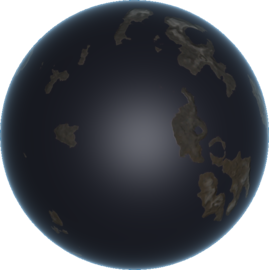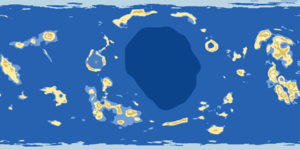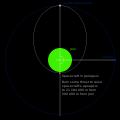Difference between revisions of "Laythe"
KerbMaster (talk | contribs) m (New releases) |
(→Oxygen) |
||
| Line 89: | Line 89: | ||
===Oxygen=== | ===Oxygen=== | ||
| − | As previously mentioned, Laythe's atmosphere contains [[w:Oxygen|oxygen]] enabling jet engines to function. Even though there is a lower concentration of oxygen than on Kerbin, plus an unknown toxic trace gas, most likely ozone, this oxygen almost surely has to be generated somewhere on Laythe. Molecular oxygen is extremely unstable compared to other atmospheric gases, and is even capable of reacting with itself to form ozone under certain conditions. Because of this unstable molecular oxygen must constantly be replaced for it to remain in any meaningful quantity in an atmosphere. This fact, combined with Laythe's extremely high concentration of liquid water, make it tempting to declare the presence of life on the moon. While it is possible that this is the case, it is also possible that the moon has a self-sustaining chemical process that constantly replenishes its oxygen reserves. | + | As previously mentioned, Laythe's atmosphere contains [[w:Oxygen|oxygen]] enabling jet engines to function. Even though there is a lower concentration of oxygen than on Kerbin, plus an unknown toxic trace gas, most likely ozone, this oxygen almost surely has to be generated somewhere on Laythe. Molecular oxygen is extremely unstable compared to other atmospheric gases, and is even capable of reacting with itself to form ozone under certain conditions. Because of this unstable molecular oxygen must constantly be replaced for it to remain in any meaningful quantity in an atmosphere. This fact, combined with Laythe's extremely high concentration of liquid water, make it tempting to declare the presence of life on the moon. While it is possible that this is the case, it is also possible that the moon has a self-sustaining chemical process that constantly replenishes its oxygen reserves.{{cn}} |
== Science == | == Science == | ||
Revision as of 23:24, 16 April 2018
| Laythe | ||
| Laythe as seen from orbit. | ||
| Moon of Jool | ||
| Orbital Characteristics | ||
| Semi-major axis | 27 184 000 m [Note 1] | |
| Apoapsis | 27 184 000 m [Note 1] | |
| Periapsis | 27 184 000 m [Note 1] | |
| Orbital eccentricity | 0 | |
| Orbital inclination | 0 ° | |
| Argument of periapsis | 0 ° | |
| Longitude of the ascending node | 0 ° | |
| Mean anomaly | 3.14 rad (at 0s UT) | |
| Sidereal orbital period | 52 981 s | |
| 2 d 2 h 43 m 0.9 s | ||
| Synodic orbital period | 53 007.7 s | |
| Orbital velocity | 3 224 m/s | |
| Longest time eclipsed | 3 754 s | |
| Physical Characteristics | ||
| Equatorial radius | 500 000 m | |
| Equatorial circumference | 3 141 593 m | |
| Surface area | 3.1415927×1012 m2 | |
| Mass | 2.9397311×1022 kg | |
| Standard gravitational parameter | 1.9620000×1012 m3/s2 | |
| Density | 56 144.728 kg/m3 | |
| Surface gravity | 7.85 m/s2 (0.8 g) | |
| Escape velocity | 2 801.43 m/s | |
| Sidereal rotation period | 52 980.879 s | |
| 2 d 2 h 43 m 0.9 s | ||
| Sidereal rotational velocity | 59.297 m/s | |
| Synchronous orbit | Outside sphere of influence | |
| Sphere of influence | 3 723 645.8 m [Note 1] | |
| Atmospheric Characteristics | ||
| Atmosphere present | Yes | |
| Atmospheric pressure | 60.7950 kPa | |
| 0.6 atm | ||
| Atmospheric height | 50 000 m | |
| 6.0×10-7 atm | ||
| Temperaturemin | -74.15 °C 199 K | |
| Temperaturemax | 3.85 °C 277 K | |
| Oxygen present | Yes | |
| Scientific multiplier | ||
| Surface | 14 | |
| Splashed | 12 | |
| Lower atmosphere | 11 | |
| Upper atmosphere | 10 | |
| Near space | 9 | |
| Outer space | 8 | |
| Recovery | 8 | |
|
| ||
Laythe is the innermost of the five natural satellites of Jool. Although mostly covered in seas, Laythe has numerous rocky, sandy islands. Laythe is tidally locked to Jool. Synchronous orbits around Laythe are not possible, as they would lie outside of its SOI, at a radius of 5,186,399 meters. A circular archipelago prominent in surface maps of the moon suggests that Laythe suffered a massive impact in its distant past.
Achieving a stable orbit around Laythe from sea level requires a delta-V of ≈2800 m/s.
Laythe has no real-world analogue. In the real-world Jupiter system, the moons Ganymede, Europa and Io form a group with an orbital resonance just like KSP's Tylo, Vall and Laythe. But while Tylo and Vall have a certain resemblance to their real-life counterparts, Laythe is very unlike Io, which is dry, volcanic, and only has a tenuous atmosphere. Instead, the presence of a liquid ocean, plus a dense atmosphere, makes Laythe more similar to the Saturnian moon Titan. Laythe also seems very similar to what happened to Europa in 2010: Odyssey Two.
Although Laythe has liquid water on its surface, its polar regions have temperatures below zero degrees Celsius even outside its ice caps. This means Laythe's oceans must contain another compound which reduces its freezing point, most likely ionic, such as salt. Surface samples indicate that much salt is present on Laythe's surface. Unlike that of Kerbin, the air cannot be breathed by Kerbals (according to EVA reports). It is therefore possible that there are also high concentrations of salt in the air, as well as on the surface, assuming that the salt is sodium chloride. The apparent toxicity of Laythe's atmosphere, despite being similar in composition to Kerbin's, may also be a reference to the film Avatar - the moon Pandora is very similar to Earth, but its atmosphere is too toxic for humans to inhale, and the moon also orbits a gas giant, like Laythe. Laythe may also be a reference to the planet Damogran from the radio/tv/book/movie series The Hitchhiker's Guide to the Galaxy, as they are almost, but not quite, entirely not unlike one another.
According to former developer NovaSilisko, Laythe was planned to have volcanic activity and high radiation levels in later versions, making it a much more hostile moon than in 1.4.2[1][2]
Contents
In-game description
| “ | When Laythe was first discovered, it was not entered in the records because the scientist in charge thought he was looking at Kerbin.
|
” |
Biomes
Laythe has 10 biomes. Laythe consists primarily of a huge ocean, called The Sagen Sea, with another ocean called the DeGrasse Sea and some small Peaks, Dunes and Shores biomes. It also has a Poles biome. The aforementioned seas are likely to be named after Neil DeGrasse Tyson and Carl Sagan, two famous physicists.
Biome list
|
Atmosphere
Laythe has an atmosphere thick enough and warm enough to support liquid water on its surface. The atmosphere has a mass of approximately 2.4×1016 kilograms, a sea level pressure of 60.795 kilopascals (0.6 atmospheres), and a depth of 50,000 meters. Compared to the atmosphere of Kerbin, Laythe's atmosphere has 1/2 the mass and 3/5ths the surface pressure. The sea level pressure on Laythe is equivalent to that at an altitude of 3,287 m on Kerbin. The atmosphere contains oxygen and can support combustion; however, it is unbreathable by Kerbals. Laythe is the only moon in the game that has an atmosphere.
The average molecular weight of Laythe air is 28.9644 g/mol, and its adiabatic index is 1.40. These values suggest a compostion very similar to Kerbin, and to Earth — likely nitrogen and oxygen.
Like all other atmospheres in the game, Laythe's atmosphere fades exponentially as altitude increases. The scale height varies with altitude, which is a change from pre-1.0 versions of the game. The pressure-altitude profile is globally constant and independent of temperature. The following table gives the atmospheric pressure at various altitudes above sea level.
| Altitude (m) | Pressure (Pa) | Pressure (atm) |
|---|---|---|
| 0 | 60 795 | 0.600 |
| 2 500 | 47 153 | 0.465 |
| 5 000 | 34 495 | 0.340 |
| 7 500 | 24 914 | 0.246 |
| 10 000 | 17 786 | 0.176 |
| 15 000 | 9 351 | 0.092 |
| 20 000 | 4 782 | 0.047 |
| 25 000 | 2 671 | 0.026 |
| 30 000 | 1 507 | 0.015 |
| 40 000 | 363.5 | 0.004 |
| 50 000 | 0 | 0.000 |
The variation of temperature with height suggests the presence of an earthlike troposphere, stratosphere and mesosphere. The warm surface temperatures rapidly decrease as the alitude increases to 5 km. The stratospheric region, where temperature rises as altitude increases, spans the region between the altitudes of 10 km and 22 km.
Air temperatures vary with latitude and time of day. At the equator, sea level temperatures vary between a nighttime low of 9 °C and a daytime high of 15 °C. Mid-latitudes are only slightly cooler than the equatorial zone — at latitudes below 63°, the sea level temperature never drops below 0 °C. At the poles, the temperature varies between -26 °C and -24 °C. The globally averaged sea level temperature is approximately 9 °C. Since Laythe has no axial tilt, there are no seasonal temperature variations.
Laythe's surface temperatures are warmer than would be expected based on its distance from the sun. This suggests the possibility that Laythe generates its own heat, likely tidal heating.
Atmospheric flight
The thickness of Laythe's atmosphere makes it suitable for aerobraking and the use of parachutes.
With proper aerobraking near Laythe and Jool, reaching Laythe may require the least Δv of all of Jool's moons. Another way is to approach Laythe directly, utilizing proper timing and making orbital adjustments on the way to Jool. Laythe's orbital period makes it an easy target to time and will have required less Δv on arrival (only 2000 m/s). As such, aerobraking on Laythe is less extreme than on Jool.
Landing on higher points of Laythe's surface has to be done with the help of retro-burns, as parachutes alone will not suffice to sufficiently lower a craft's velocity for landing.
Jet engines work in Laythe's atmosphere due to the presence of oxygen. However, the air-intake efficiency is lower there.
Oxygen
As previously mentioned, Laythe's atmosphere contains oxygen enabling jet engines to function. Even though there is a lower concentration of oxygen than on Kerbin, plus an unknown toxic trace gas, most likely ozone, this oxygen almost surely has to be generated somewhere on Laythe. Molecular oxygen is extremely unstable compared to other atmospheric gases, and is even capable of reacting with itself to form ozone under certain conditions. Because of this unstable molecular oxygen must constantly be replaced for it to remain in any meaningful quantity in an atmosphere. This fact, combined with Laythe's extremely high concentration of liquid water, make it tempting to declare the presence of life on the moon. While it is possible that this is the case, it is also possible that the moon has a self-sustaining chemical process that constantly replenishes its oxygen reserves.[citation needed]
Science
Laythe is the most science-rich body in the Joolian moon system. Even though Tylo has a slightly higher science multiplier for both surface and orbit, Laythe's atmosphere and oceans allow a lot more experiments to be performed, which means the total science output is higher.
Reference frames
| Time warp | Minimum Altitude |
|---|---|
| 1× | Any |
| 5× | 50 000 m (above the atmosphere) |
| 10× | 50 000 m (above the atmosphere) |
| 50× | 60 000 m |
| 100× | 120 000 m |
| 1 000× | 240 000 m |
| 10 000× | 480 000 m |
| 100 000× | 600 000 m |
Gallery
Changes
- Added biomes
- Atmosphere reduced
- Added biomes
- Initial Release


















